Exploring the High Power Induction Cooktop
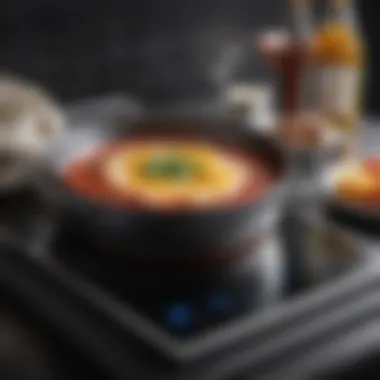
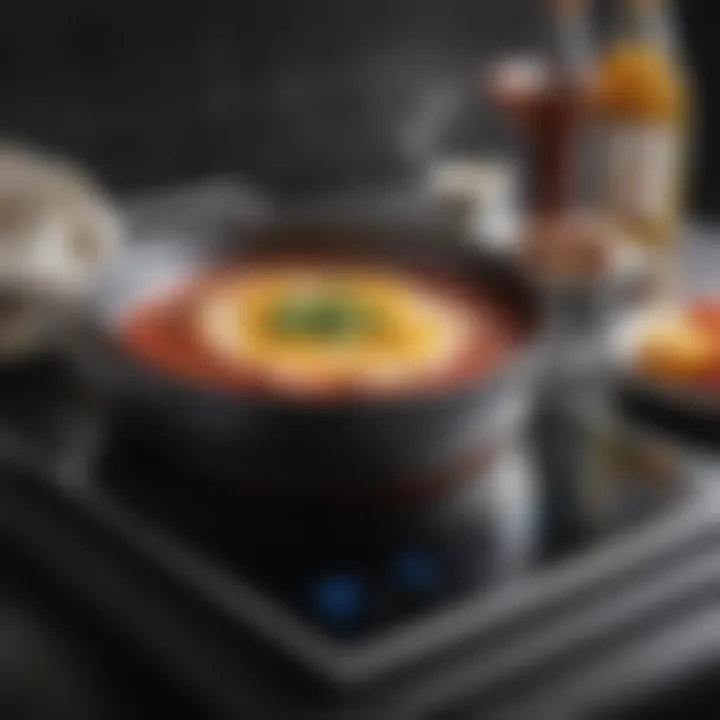
Intro
High power induction cooktops have carved a niche within kitchens, both professional and home settings, by offering unprecedented efficiency and control over the cooking process. These appliances operate on principles of electromagnetic induction, creating a magnetic field that directly heats cookware. Not only does this technology permit swift cooking times, it also affords incredible accuracy when managing heat levels.
The ever-evolving culinary scene has propelled many food lovers and professionals to embrace induction cooking. This exploration aims to shine a light on the device's inner workings, benefits, and pertinent considerations for optimal use. Within these pages, you'll encounter diverse features of induction cooktops—from energy efficiency to safety measures—building a bridge between traditional cooking practices and modern culinary advancements.
As we embark on this culinary journey, there are a few key themes to keep in mind:
- Efficiency and Speed: How induction cooktops compare to gas and electric models when it comes to cooking time and energy usage.
- Versatility: Insights on the various types of cookware suitable for induction cooking and their characteristics.
- Safety First: Examining the safety features that induction cooktops boast over conventional cooking methods.
- Cooking Techniques: Discussing techniques and recipes that will elevate your culinary experience using induction technology.
By the end of this article, you will have a deeper understanding of high power induction cooktops, making you better equipped to decide if this technology suits your culinary needs.
Prologue to Induction Cooking
Induction cooking is a modern marvel that has changed the way we heat our kitchens. This method harnesses the power of magnetism to create heat directly in the cookware, which makes it quite different from the conventional gas or electric stoves most of us are used to. The importance of understanding induction cooking lies not just in its approach but in its wide-ranging benefits, making it a hot topic among culinary enthusiasts and professionals alike.
Induction cooktops have gained popularity due to their energy efficiency, fast heating times, and enhanced safety features. They offer the ability to precisely control temperature, giving chefs the power to craft dishes with a level of accuracy that would impress even the most discerning food lovers. Furthermore, the clean and sleek design of induction cooktops appeals to contemporary kitchen aesthetics.
The Evolution of Cooking Technologies
Cooking technology has come a long way, from primitive fire pits to the sophisticated kitchen ranges we see today. In the early days, humans relied on open flames, a method that’s as simple as it is limiting. Then came the era of stoves that used coal or wood, offering more control but still battling issues like heat distribution and safety.
With the advent of gas stoves in the 19th century, cooking became more tailored, allowing for a potent blend of convenience and control. But even these had their drawbacks, particularly regarding energy efficiency and safety.
The introduction of electric stoves marked another significant milestone, improving uniformity in heat but still falling short in certain aspects. Enter induction cooking, which combines the best of both worlds, providing precision and efficiency while minimizing the risks associated with open flames. This technological leap is a reaction to our evolving understanding of food preparation, safety, and energy consumption, making induction cooktops not just another tool—but an essential innovation in modern kitchens.
Overview of Induction Cooktops
Induction cooktops are characterized by their sleek surfaces and innovative heating method. They utilize electromagnetic fields to generate energy directly in induction-compatible cookware. This means that only the pot or pan gets hot; the cooktop itself remains cool to the touch after use, minimizing the risk of burns.
These cooktops come in various sizes and configurations, suitable for all kinds of kitchens—be it a compact apartment or a spacious culinary haven. Users can find options featuring multiple burners, different heat levels, and even touch controls for a more user-friendly experience.
Notably, the types of cookware that can be used on these cooktops are vital to their functionality. Cookware made from magnetic materials, such as cast iron or stainless steel, works best. As a result, it’s essential for users to choose their pots and pans wisely, ensuring that they are compatible with induction technology.
To put it simply, induction cooktops are not only a testament to the technological advancements in cooking but also signal a shift towards smarter, more energy-conscious kitchen practices.
"Induction cooking is not just about efficiency; it’s a transformative approach to how we engage with the culinary arts."
Understanding High Power Induction Cooktops
Grasping the essence of high power induction cooktops is paramount as this technology transforms how we cook. These cooktops not only enhance the efficiency and speed with which meals are prepared, but they also offer a range of unique benefits that cater to the needs of modern kitchens. Delving into this subject allows a culinary enthusiast to appreciate how the right tools can elevate everyday cooking into a sophisticated experience for both professionals and home cooks alike.
What Defines High Power Induction
High power induction cooktops stand out primarily due to their impressive wattage output. Unlike standard induction cooktops that might hover around 1,800 watts, high power models can exceed 3,500 watts. This increase in power is a game-changer, allowing for rapid heating and improved cooking times. It’s akin to shifting gears in an automobile; the increased engine capacity delivers performance that can whip up a gourmet dish faster than ever before.
Moreover, high power induction also signifies exceptional responsiveness to temperature adjustments. When you turn down the heat, the cooktop reacts immediately, which eliminates the frustrating lag often experienced with gas ranges or traditional electric stoves. Cooktops like the Breville BSI201 are a fine example of how these features can coalesce to provide an effective cooking environment.
Key Technical Specifications
When evaluating high power induction cooktops, several technical specifications merit attention. Here’s a rundown:
- Power Levels: Cooktops often feature multiple power settings, making them versatile for various cooking tasks, from simmering sauces to searing meats.
- Zone Sizes: Variations in cooking zones cater to different pot sizes. Larger zones, like those on the Bosch 800 Series, accommodate bigger cookware, making batch cooking a breeze.
- Control Features: Digital touch controls enhance precision. Some models offer sliders instead of buttons, allowing for fine-tuned adjustments. It’s a modern twist on the traditional experience.
- Smart Technology: Integration with smart home systems is increasingly common. This means timers and temperature settings can be adjusted remotely, providing flexibility.
- Safety Features: Functions like auto shut-off, pan detection, and child lock mechanisms are crucial for both new and experienced cooks. They ensure safety in bustling kitchens.
"The right specs can make all the difference; smarter choices lead to better food outcomes."
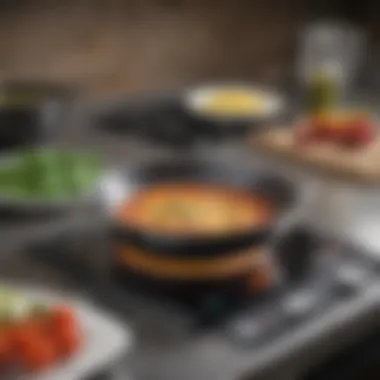
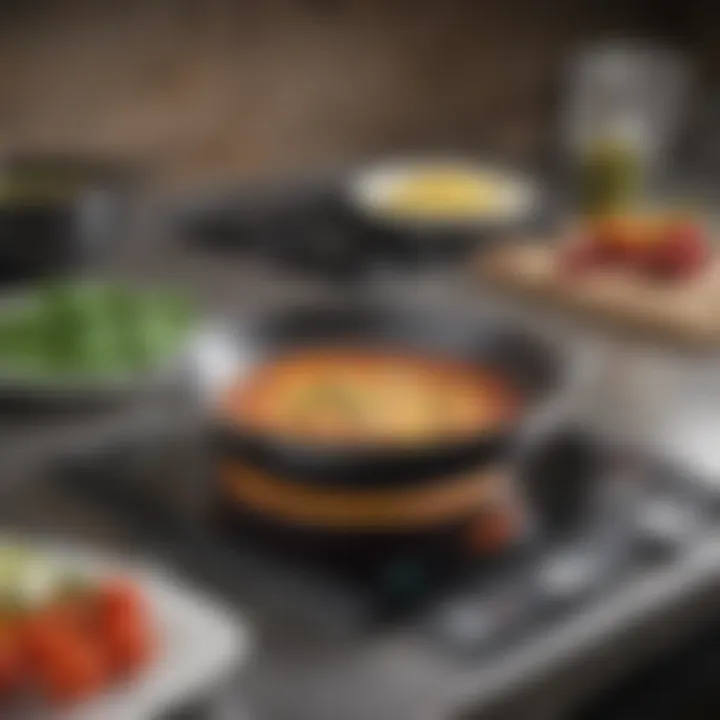
Understanding these fundamental characteristics is invaluable for anyone thinking about making a switch. A high power induction cooktop not only translates to enhanced cooking efficiency but also aligns with energy-saving practices, minimizing electric bills and reducing environmental impact.
The Advantages of Induction Cooking
Induction cooking isn't just a passing trend; it marks a real shift in how we approach our culinary tasks. The string of benefits it brings to the table—ranging from efficiency to safety—makes it an appealing option for cooks of any caliber. Each advantage contributes to a more effective and enjoyable cooking experience, making induction cooktops deserving of attention in today's kitchens.
Energy Efficiency and Sustainability
When we talk about induction cooking, energy efficiency takes center stage. These cooktops utilize electromagnetic energy to directly heat the cookware, resulting in less heat loss compared to gas or electric options. To put it simply, it’s like having a turbo engine in a race car: the power goes where it’s most needed. This translates to up to 70% more efficient cooking, as heat is concentrated solely on the pot or pan. Furthermore, because induction cooktops don’t waste energy heating up the surrounding air, they contribute to a reduction in overall household energy consumption.
"Induction cooking is like a swift river current, directing every drop of energy right where it's needed."
In an age where climate change is at the forefront, choosing an induction cooktop is a proactive step towards sustainability. Not only do they consume less power overall, their use aids in decreasing the carbon footprint associated with conventional cooking methods. Additionally, the reduced cooking time means fewer emissions released into the environment during meal preparation.
Precision in Temperature Control
One of the crowning jewels of induction cooking is its unparalleled temperature control. Imagine sautéing vegetables and having the ability to switch from a brisk boil to a gentle simmer with the flick of a dial. This kind of responsiveness ensures that delicate dishes, like sauces or chocolate, can be prepared without the risk of burning.
Induction cooktops provide immediate heat adjustment, which is not the norm for traditional stovetops that still hold residual heat long after being turned off. This quality is particularly crucial for those who consider themselves serious home chefs, as consistent temperatures are vital for achieving professional-grade results. Cookware heats uniformly, and because induction works by heating the pot itself, you’re less likely to have hotspots that can ruin a dish.
Safety Features and Design
Safety is a major consideration when selecting kitchen appliances, and induction cooktops have several features that ensure peace of mind.
- Cool Surface: Since heat is generated directly in the pan, the surface of the cooktop remains relatively cool, greatly reducing the risk of burns.
- Automatic Shutoff: Should a pot boil dry, many induction cooktops will automatically turn off, preventing potential hazards.
- Child Lock Features: Many models include designs specifically aimed at preventing accidental adjustments, making them family-friendly options.
In terms of design, induction cooktops offer sleek, modern aesthetics that easily fit into various kitchen styles. Their flat surfaces fit well in minimalistic setups, and because they can be integrated seamlessly into countertops, kitchen space appears larger and less cluttered.
All in all, the advantages of induction cooking not only address essential culinary needs but also contribute to a more efficient and safer kitchen environment. As we explore further sections, it becomes clear that these cooktops represent a significant leap in modern cooking technology.
Comparative Analysis with Traditional Cooking Methods
Cooking is an art, and understanding the tools of the trade is paramount for any culinary aficionado. When we stack high power induction cooktops against traditional cooking methods, there’s a treasure trove of insights waiting to unfold. This section delves into the significant differences between these two styles of cooking, focusing on heat transfer efficiency and performance speed, both of which play crucial roles in elevating the cooking experience. Drawing a comparison offers an appreciation of new technologies while also highlighting the advantages and potential drawbacks of conventional methods.
Efficiency in Heat Transfer
One of the first things to grasp when comparing induction cooktops to traditional cooking methods is the efficiency of heat transfer. Induction cooktops use magnetic fields to directly heat pots and pans. This technique claims heat only where it’s needed, making it an incredibly effective option.
- Rapid Response: Induction heats up faster because the heat is produced directly within the cookware. This response to temperature changes is something traditional gas or electric burners can’t replicate. You turn it up, and the heat is instant. Alternatively, traditional methods have a delay that many might find frustrating.
- Less Heat Loss: Around 90% of the heat produced by induction ends up in the food, compared to only about 60-75% with gas or electric stoves. This significant difference not only means quicker cooking time but also a more energy-efficient use of resources.
"Embracing induction cooking is like putting your culinary skills into hyperdrive—simpler, smarter, and significantly faster."
Cooking can often lead to a mess of wasted energy, but with an induction cooktop, that’s less of a concern. By reducing the heat loss to the kitchen air, chefs can also cook in a cooler environment.
Cooking Speed and Performance
Now let’s chat about cooking speed and performance, the crown jewels that many chefs and home cooks are itching to understand.
- Faster Cooking Times: Not only do induction cooktops reach temperature quicker, but they also allow for more precise temperature adjustments thanks to their immediate responsiveness. When you’re racing against the clock to whip up dinner, a few seconds can make all the difference. With traditional cooking, the waiting game often prolongs meal preparation unnecessarily.
- Consistent Results: With the capability to maintain consistent temperatures, induction cooking minimizes any guesswork. Whether you’re simmering sauces or searing meats, the assurance of even heating leads to optimal results. Traditional cooking methods can sometimes serve up unpredictability, leaving you with overcooked or undercooked meals at times.
When diving into performance, enthusiasts should note that user experience also matters. The tactile joy of adjusting a knob on a gas flame is often seen as a nostalgic feature, but indeed, induction’s reliability and convenience simplify the process for even novice cooks. The cooking surface remains cooler, reducing burns and mishaps—a game-changer when you have multiple pots bubbling away.
As we explore the culinary landscape shaped by induction technology, understanding its advantages over traditional cooking methods sheds light on how we might move forward in our cooking journeys. The efficiency of heat transfer and the enhanced cooking speed are significant aspects that elevate high power induction cooktops above the classics—placing them firmly at the forefront of modern culinary technology.
Integration and Installation Considerations
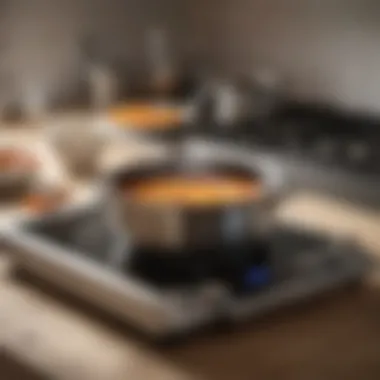
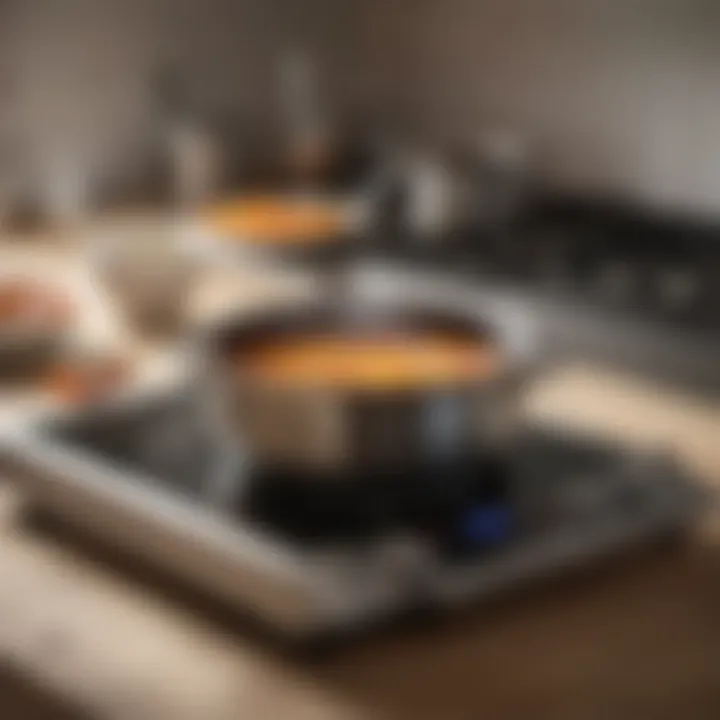
When diving into the realm of high power induction cooktops, understanding the nuances of integration and installation is paramount. Using the technology effectively requires not just selecting the right model, but also ensuring it finds a harmonious place in your kitchen setup. Ignoring these considerations can lead to a sub-optimal cooking environment, and potentially, unresolved technical issues.
Requirements for Electrical Systems
A key aspect of integrating an induction cooktop revolves around electrical requirements. These cooktops need a dedicated high-voltage outlet; typically, a 240-volt connection. Most residential kitchens are wired for standard 120-volt appliances, so this often means an upgrade in the electrical system.
If you are contemplating an installation, consider these essential points:
- Check the Amperage: High power induction cooktops generally draw around 30-50 amps. Your home’s wiring must accommodate this. If the amperage isn’t sufficient, circuit breakers may trip.
- Consult a Professional Electrician: Always advisable. They can assess your existing wiring and make recommendations tailored to your specific kitchen setup and cooktop model.
- Consider Dedicated Circuits: Induction cooktops can demand significant power. A dedicated circuit reduces the potential strain on shared circuits, minimizing risk of electrical overload.
Addressing these elements not only ensures safety, but also enhances performance. An inadequate electrical supply can diminish the cooktop's efficiency, leaving users frustrated at the stove.
Optimal Kitchen Layouts
The layout of your kitchen plays a crucial role in how well your high power induction cooktop integrates into your cooking space. It's about creating an efficient workflow while maximizing the cooktop's potential. Key aspects to think about include:
- Proximity to Other Appliances: Ideally, the cooktop should be within arm's reach of your oven and refrigerator, promoting an efficient cooking process. Long distances can disrupt your flow, making meal prep tedious.
- Ventilation Considerations: While induction cooktops produce less ambient heat compared to gas ranges, some form of ventilation is still beneficial. Ensure that your cooktop is positioned in such a manner that maximizes air circulation around it.
- Counter Space: Ample space around the cooktop is vital. This is where chopping, mixing, and plating will take place, so positioning it in an area where you won't feel cramped can be game-changing.
Having the right kitchen layout enhances not only your cooking experience but also contributes to safety. Engaging in thoughtful design brings out the best in high power induction cooking.
"The kitchen is the heart of the home, and every element should work in concert to enhance culinary creativity."
In summary, careful consideration of the electrical requirements and kitchen layout when integrating a high power induction cooktop will pave the way for a smoother, more enjoyable cooking experience.
Utilizing High Power Induction Cooktops
Induction cooking stands out in the culinary world, offering an approach that is both technologically advanced and practically efficient. Understanding how to effectively utilize high power induction cooktops can greatly enhance your cooking experience. This section concentrates on essential aspects that should be considered when using these cooktops, emphasizing the variety of cookware options and unique cooking techniques that set induction apart from traditional methods.
Selecting the Right Cookware
Choosing the right cookware for your induction cooktop is crucial. Not all pots and pans are fit for induction cooking due to its unique heating method. Here are some key pointers:
- Magnetic Material: Cookware must have a magnetic base or be ferromagnetic. Stainless steel and cast iron are great choices because they work well with induction heating. Cookware made from aluminum or copper, unless clad with a magnetic material, typically won’t do the trick.
- Flat Bottoms: The base of the pot or pan should be flat and smooth to ensure optimal contact with the cooktop. This maximizes heat transfer and improves efficiency.
- Size Matters: Your cookware should match the size of the induction burner. Using a pot that is too small can result in uneven heating, while one that is too large might not fit well.
- Special Features: Some high-end cookware come with features designed for induction cooking, such as improved heat distribution and durability against warping.
For a successful cooking experience, invest in high-quality cookware that is explicitly labeled as induction-compatible. It's worth it in the long run.
Cooking Techniques Unique to Induction
Induction cooking isn't just about speed; it's also about precision and control. There are several unique techniques that can be employed:
- Immediate Response: Induction cooktops heat up super quickly, which allows chefs to adjust temperatures more efficiently. This leads to better control during the cooking process.
- Simmering and Boiling: With induction, water can reach a boiling point in a fraction of the time compared to gas or traditional electric methods. This makes cooking pasta or boiling vegetables a breeze.
- Low-Temperature Techniques: Induction allows for incredibly low and stable temperatures, making it great for tasks like melting chocolate or preparing delicate sauces. The art of sous-vide also benefits from the ability to maintain consistent, low temperatures.
"The precision that induction cooking offers allows for culinary experiments that would be harder to achieve using traditional methods."
- Safety and Supervision: Since the cooktop itself doesn't heat up (only the cookware does), there’s less chance of accidental burns or kitchen fires. This means cooks can focus more on their culinary craft rather than on keeping a close eye on a flame or hot surface.
By understanding how to select the right cookware and the techniques unique to induction cooktops, cooks can elevate their kitchen game. Attention to these details can make the cooking process smoother and more enjoyable, bringing culinary creations to life with precision and speed.
Maintenance and Care for Induction Cooktops
Taking care of your induction cooktop goes beyond common cleaning; it's about enhancing its longevity and ensuring peak performance. For those who have made the switch to this modern cooking technology, proper maintenance means reaping the full benefits of efficiency and precision that high power induction cooktops offer. Let's delve into some crucial aspects of keeping these appliances in tip-top shape.
Cleaning Protocols and Best Practices
Cleaning an induction cooktop is quite different from traditional stoves. Here are some specific protocols to follow:
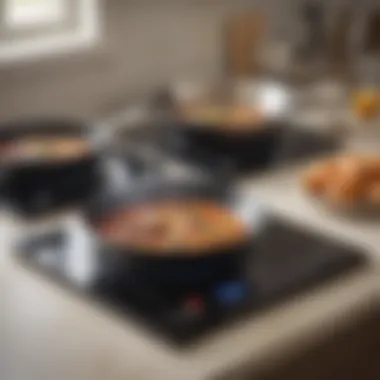
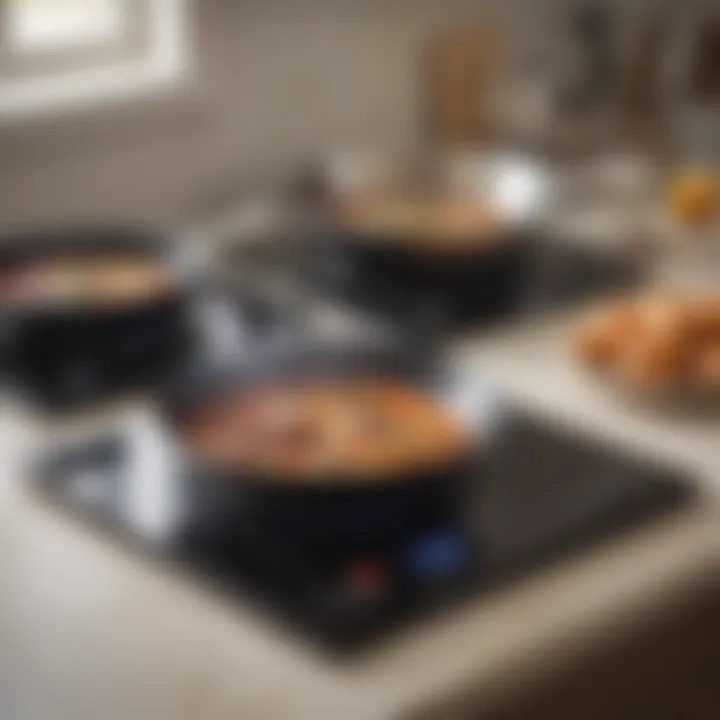
- Use the Right Cleaners: Always opt for cleaners specifically designed for glass or ceramic surfaces. Avoid abrasive pads or cleaners that could scratch the cooktop. Gentle cleansers are your best friend here.
- Immediate Cleanup: Wipe spills as soon as the surface cools down. If you let them sit, they can harden and become tougher to remove.
- Soft Cloths: Michelangelo, you are not! A simple microfiber cloth does wonders. Dampen it slightly to avoid scratching while wiping.
- Repair Marks: If your cooktop has minor scratches, there are repair kits available to keep it looking fresh.
"A little care can go a long way in preserving the beauty and performance of your cooktop."
Steps for Daily Maintenance:
- Daily Wipe Down: Make it a habit to wipe down after each use.
- Check For Residue: Before using again, ensure there's no leftover residue that could affect cooking.
- Regular Deep Cleaning: Once a month, give it a thorough clean with a glass cleaner to remove any stubborn stains.
- Inspect Seals: Check for any damage around the edges or control panels every so often.
Troubleshooting Common Issues
Even though high power induction cooktops are known for reliability, problems can still arise. Here are some common issues and how to fix them:
- Cooktop Not Responding: Ensure it's plugged in and receiving power. Sometimes the control lock feature might be activated. Refer to your user manual to unlock.
- Error Codes Displayed: If you're seeing random error codes, consult the user manual. These codes often tell you if the cookware isn't compatible or if there's an overheating issue.
- Inconsistent Heat Distribution: This could stem from using unsuitable cookware. Make sure your pots and pans are magnetic and designed for induction cooking.
- Noise During Cooking: A hum or buzz is normal due to the induction process. However, excessive noise might indicate a problem with the unit or the cookware.
Quick Fix Checklist:
- Are you using compatible pans? Check if your cookware has a flat bottom and is ferrous.
- Inspect the Power Supply: Make sure everything is working at the wall outlet.
- Reset the Cooktop: Sometimes, a simple reset can do the trick.
By implementing these maintenance techniques and addressing common frustrations, your high power induction cooktop can serve you well for years to come, promoting an enjoyable cooking experience without the fuss.
Future Trends in Cooking Technology
Looking ahead, future trends in cooking technology hold significant promise for enhancing our culinary experiences, especially within the realm of high power induction cooktops. As the culinary world constantly evolves, staying abreast of advancements plays a crucial role for both enthusiasts and professional cooks alike. These transitions are not merely about new gadgets; they encompass improvements in how we cook, efficiency, and overall enjoyment in the kitchen. This section focuses on critical innovations and the integration of smart technologies, setting the stage for a new generation of cooking practices.
Innovation in Induction Heating
Induction heating continues to redefine the way heat is generated in culinary applications. Unlike conventional methods where heat radiates from a flame or from electric coils, induction technology uses electromagnetic fields to directly heat pots and pans. This feature not only boosts energy efficiency but also minimizes heat loss, creating a safer cooking environment. For instance, as soon as a pan is removed from the cooktop, the heat instantly stops, reducing the risk of burns.
Moreover, manufacturers are continuously improving the sensitivity and quickness of induction systems. Advanced models now offer faster response times and finer temperature adjustments. Imagine a scenario where you can switch from a rolling boil to a simmer in an instant—this adaptability resonates well with culinary precision, particularly for delicate sauces or candy-making.
"The future of cooking is about more than just heat; it’s about intelligent heat cooking with confidence."
Smart Cooking and Integration with IoT
In an age where everything is connected, the incorporation of Internet of Things (IoT) technologies into cooking is making waves. High power induction cooktops are not lagging behind; they are embracing connectivity in homes. This shift allows cooks to control their cooking environment remotely. You can start preheating your cookware while you’re still commuting home—a sweet relief after a long day.
Furthermore, smart induction cooktops can synchronize with mobile applications. This means recipes can be monitored through step-by-step guides directly interfacing with your appliance. Some advanced units even adjust their settings automatically based on the recipe parameters, ensuring precise results every time.
- Voice control capabilities allow for hands-free adjustments—imagine asking your cooktop to raise the temperature without breaking your focus on stirring.
- Integration with smart home systems enables coordination with devices like smart refrigerators, suggesting recipes based on available ingredients.
- Data tracking in some cooktops allows users to measure and analyze energy consumption, promoting a more sustainable cooking routine.
Ultimately, these innovations signal a shift towards a more interactive, precise, and sustainable cooking realm, showcasing how technology can elevate our everyday cooking experiences.
Finale: The Role of High Power Induction Cooktops
High power induction cooktops are setting a new standard in culinary technology, reshaping the way we approach cooking. This conclusion seeks to highlight their impact, weaving together the insights we’ve gathered throughout the article. Whether you are a professional chef or a passionate home cook, understanding these cooktops’ role in modern kitchens has become crucial.
Revisiting Key Insights
As we've discussed, the efficiency and precision of high power induction cooktops stand as their cornerstone features. They utilize electromagnetic energy to create heat directly in compatible cookware, minimizing energy loss and providing quick temperature adjustments. This results in speedy cooking times and significantly faster boil times compared to traditional methods. Additionally, the safety features inherent in many models, such as automatic shut-offs and cool-to-the-touch surfaces, add layers of practicality to their usage.
- Energy Efficiency: Induction cooktops use up to 90% of the energy produced, whereas gas and electric cooktops may only use about 40-60% efficiently.
- Precision Control: The ability to adjust heat instantly allows for better meal preparation and cooking techniques.
- Safety and Cleanliness: The cooktop remains cool, reducing the risk of burns and making cleanup easier.
In summary, high power induction cooktops not only streamline the cooking process but also prioritize safety and energy consumption, reinforcing their position as a smart kitchen investment. As we embrace this technology, it’s important to note that each cooktop comes with specific requirements, and taking time to understand these will go a long way in enhancing your cooking experience.
Final Thoughts on Culinary Advancement
The future of cooking undeniably leans towards induction technology. As home designs and culinary trends evolve, more kitchens choose to incorporate high power induction cooktops. They represent a convergence of convenience, efficiency, and safety, making them attractive options for any cooking enthusiast.
Possessing one means you’re equipped not just with a cooking appliance, but with a tool that could change how you create. Culinary artisans can experiment with varying techniques, achieving results that were previously hindered by older technologies. Moreover, consider how this appliance aligns with a growing interest in sustainability; as we become more wary of our energy consumption, induction cooktops present a practical response.
In the words of a seasoned chef: “It’s not just about cooking meals; it’s about crafting experiences.”
Indeed, moving forward, embracing high power induction cooktops will empower culinary exploration, enabling chefs of all levels to push their boundaries. The shift is not merely technological; it’s a revolution in how food is prepared, experienced, and shared. By understanding the full capabilities of induction cooking, we prepare ourselves for a future where food innovation knows no bounds.







